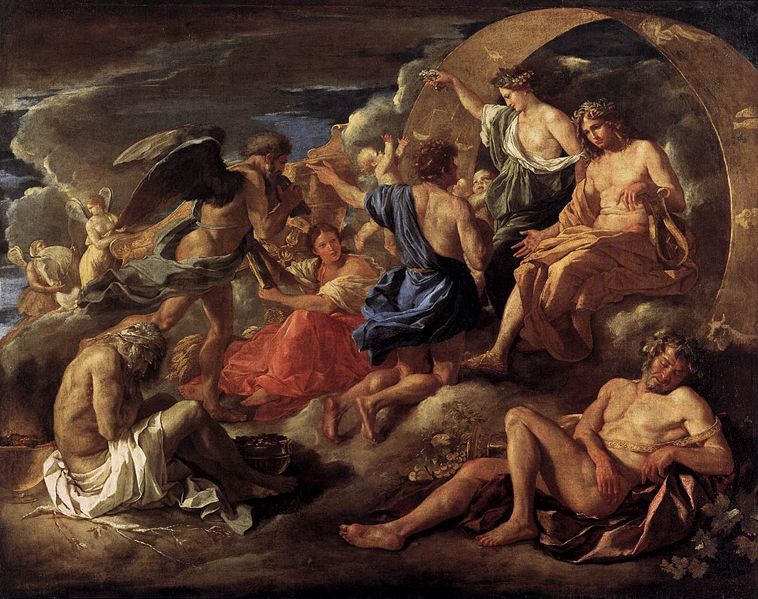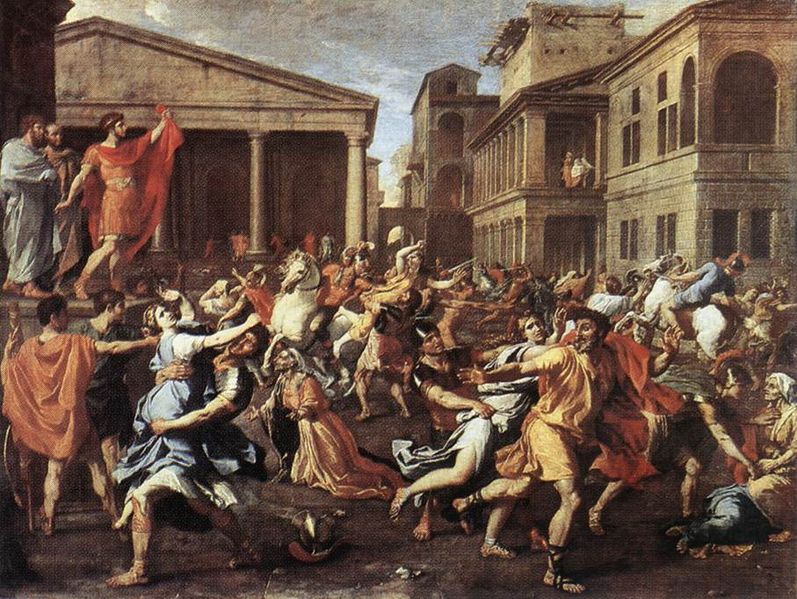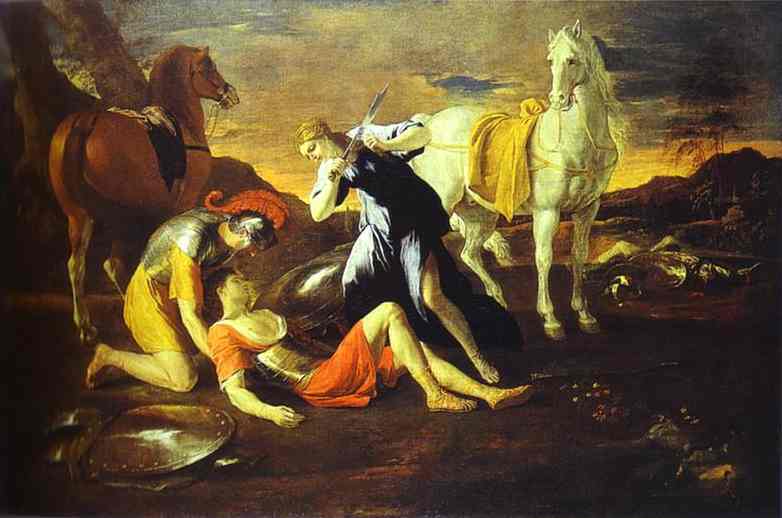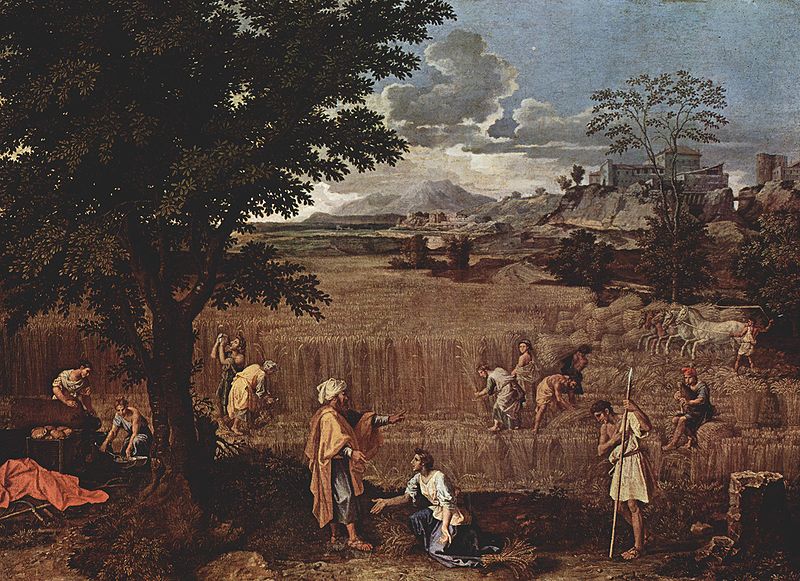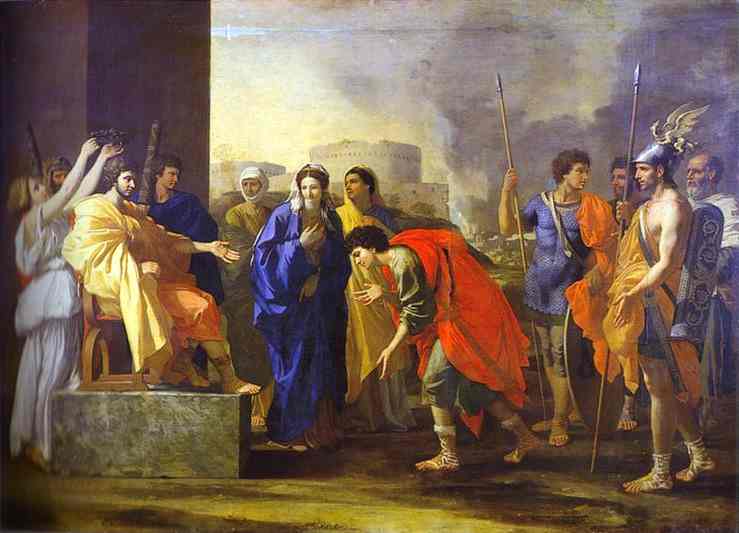<Back to Index>
- Psychologist Erik Erikson, 1902
- Painter Nicolas Poussin, 1594
- Prime Minister of Romania Ion Victor Antonescu, 1882

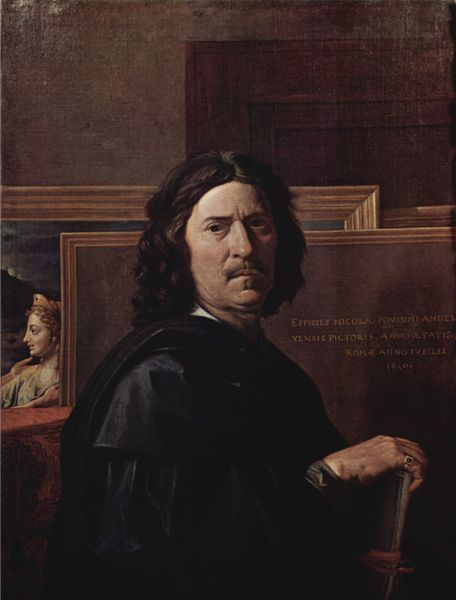
Nicolas Poussin (15 June 1594 – 19 November 1665) was a French painter in the classical style. His work predominantly features clarity, logic, and order, and favors line over color. His work serves as an alternative to the dominant Baroque style of the 17th century. Until the 20th century he remained the major inspiration for such classically-oriented artists as Jacques-Louis David and Paul Cézanne. He spent most of his working life in Rome, except for a short period when Cardinal Richelieu ordered him back to France to serve as First Painter to the King.
Nicolas Poussin's early biographer was his friend Giovanni Pietro Bellori, who relates that Poussin was born near Les Andelys in Normandy and that he received an education that included some Latin, which would stand him in good stead. Early sketches attracted the notice of Quentin Varin, a local painter, whose pupil Poussin became, until he ran away to Paris at the age of eighteen. There he entered the studios of the Flemish painter Ferdinand Elle and then of Georges Lallemand, both minor masters now remembered for having tutored Poussin. He found French art in a stage of transition: the old apprenticeship system was disturbed, and the academic training destined to supplant it was not yet established by Simon Vouet; but having met Courtois the mathematician, Poussin was fired by the study of his collection of engravings by Marcantonio Raimondi after Italian masters. After two abortive attempts to reach Rome, he fell in with Giambattista Marino, the court poet to Marie de Medici, at Lyon. Marino employed him on illustrations to his poem Adone and on a series of illustrations for a projected edition of Ovid's Metamorphoses, took him into his household, and in 1624 enabled Poussin (who had been detained by commissions in Lyon and Paris) to rejoin him at Rome. It has been suggested that it was this early friendship with Marino, and the commissioning of illustrations of his poetry (which drew on Ovidian themes), that founded, or at least reinforced, the prominent eroticism in Poussin's early work.
Poussin was thirty when he arrived in Rome. At first he lodged with Simon Vouet. Through Marino, he had been introduced to Marcello Sacchetti who in turn introduced him to another of his early patrons, Cardinal Francesco Barberini. Financial difficulties arose with the departure to Spain of Barberini, accompanied by Cassiano dal Pozzo,
the antiquarian and the Cardinal's secretary, who later would become a
great friend and patron. However, their return from Spain in 1626
stabilized Poussin’s position, with renewed patronage by the Barberini
and their circle. Two major commissions at this period resulted in
Poussin's early masterwork, the Barberini Death of Germanicus (1628), partly inspired by the reliefs of the Meleager sarcophagus, and the commission for St. Peter's that amounted to a public debut, the Martyrdom of St. Erasmus (1629, Vatican Pinacoteca), indebted to designs on the same subject by the contemporary Baroque painter, Pietro da Cortona. He
fell ill at this time and was taken into the house of his compatriot
Jacques Dughet, where he was nursed by Dughet’s daughter, Anna Maria,
who Poussin married in 1630. His two brothers-in-law were artists and Gaspard Dughet later took Poussin’s surname. During
the late 1620s and 1630s, he had the opportunity to experiment and
formulate his own stance in painting with reference to others which he
did through study of the Antique and works such as Titian’s Bacchanals at the Casino Ludovisi and the paintings of Domenichino and Guido Reni. At
the same time, the Roman Baroque was emerging: in the 1620s Cortona was
producing his early Baroque paintings for the Sacchetti family; Bernini, having established his reputation in sculpture, was designing the great bronze baldachin in St. Peter’s; and an ingenious architectural imagination was emerging in works by Borromini. Poussin
became acquainted with other artists in Rome and tended to befriend
those with classicizing artistic leanings: the French sculptor François Duquesnoy who he lodged with in 1626; the French artist Jacques Stella; Claude Lorraine; Domenichino; Andrea Sacchi; and joined an informal academy of artists and patrons opposed to the current Baroque style that formed around Joachim von Sandrart. At the time the papacy was Rome’s foremost patron of the arts. Poussin’s Martyrdom of St. Erasmus for
St. Peter’s was Poussin’s only papal commission, secured for him by
Cardinal Barberini, the papal nephew, and Poussin was not asked again
to contribute major altarpieces or paint large scale decorations for a
pope. His subsequent career depended on private patronage. Apart from Cardinal Francesco Barberini, his first patrons included Cardinal Aluigi Omodei, for whom he produced the Triumphs of Flora (c 1630–32, Louvre); Cardinal de Richelieu, who commissioned various Bacchanals; Vincenzo Giustiniani, for whom he painted the Massacre of the Innocents (uncertain early date, Museé Condé, Chantilly); Cassiano dal Pozzo who became the owner of the first series of the Seven Sacraments (late 1630s, Belvoir Castle); and Paul Fréart de Chantelou, with whom Poussin, at the call of Sublet de Noyers, returned to France in 1640. Louis XIII conferred
on him the title of First Painter in Ordinary. In two years at Paris he
produced several pictures for the royal chapels (the Last Supper, painted for Versailles, now in the Louvre), eight cartoons for the Gobelins tapestry manufactory, the series of the Labors of Hercules for the Louvre, the Triumph of Truth for Cardinal Richelieu (Louvre), and much minor work. In 1643, disgusted by the intrigues of Simon Vouet, Fouquières and the architect Jacques Lemercier, Poussin withdrew to Rome. There, in 1648, he finished for de Chantelou the second series of the Seven Sacraments (Bridgewater Gallery), and also his noble Landscape with Diogenes (Louvre).
This painting shows the philosopher discarding his last worldly
possession, his cup, after watching a man drink water by cupping his
hands. In 1649 he painted the Vision of St Paul (Louvre) for the comic poet Paul Scarron, and in 1651 the Holy Family (Louvre) for the duc de Créquy. Year by year he continued to produce an enormous variety of works, many of which are included in the list given by Félibien. He
suffered from declining health after 1650, and was troubled by a
worsening tremor in his hand, evidence of which is apparent in his late
drawings. He died in Rome on 19 November 1665 and was buried in the church of San Lorenzo in Lucina, his wife having predeceased him. Chateaubriand in 1820 donated the monument to Poussin. Poussin left no children, but he adopted as his son Gaspard Dughet (Gasparo Duche), his wife's brother, who became a painter and took the name of Poussin. Throughout
his life Poussin stood apart from the popular tendency toward the
decorative in French art of his time. In Poussin's works a survival of
the impulses of the Renaissance is coupled with conscious reference to the art of classical antiquity as the standard of excellence. His goal was clarity of expression achieved by disegno or ‘nobility of design’ in preference to colore or color. Perhaps his concern with disegno can
best be seen in the line engraved copies of his works; among the many
who reproduced his paintings, some of the most successful are Audran, Claudine Stella, Picart and Pesne. Themes of tragedy and death are prevalent in Poussin's work. Et in Arcadia ego, a subject he painted twice,
exemplifies his cerebral approach. In this composition, idealized
shepherds examine a tomb inscribed with the title phrase, which is
usually interpreted as a memento mori: "Even in Arcadia I exist", as if spoken by personified Death.
Poussin intended his figures to "display the most distilled and most
typical attitude and emotion for the role they were playing", but he
was concerned with emotion "in a generalized and not specific way ...
Thus in both compositions of Et in Arcadia Ego (Chatsworth
and Louvre) the theme is the realization of death in life. The specific
models hardly matter. We are not intended to have sympathy with them
and instead we are forced by the artist to think on the theme." Poussin is an important figure in the development of landscape painting.
In his early paintings the landscape usually forms a graceful
background for a group of figures; later he progressed to the painting
of landscape for its own sake, although the figure is never entirely
absent. Examples are Landscape with St. John on Patmos (1640), (Art Institute of Chicago) and Landscape with a Roman Road (1648), (Dulwich College Picture Gallery). The
finest collection of Poussin's paintings is at the Louvre in Paris.
Other significant collections are in the National Gallery in London;
the National Gallery of Scotland; the Dulwich Picture Gallery; the Musée Condé, Chantilly; the Hermitage Museum, St. Petersburg; and the Museo del Prado, Madrid.
